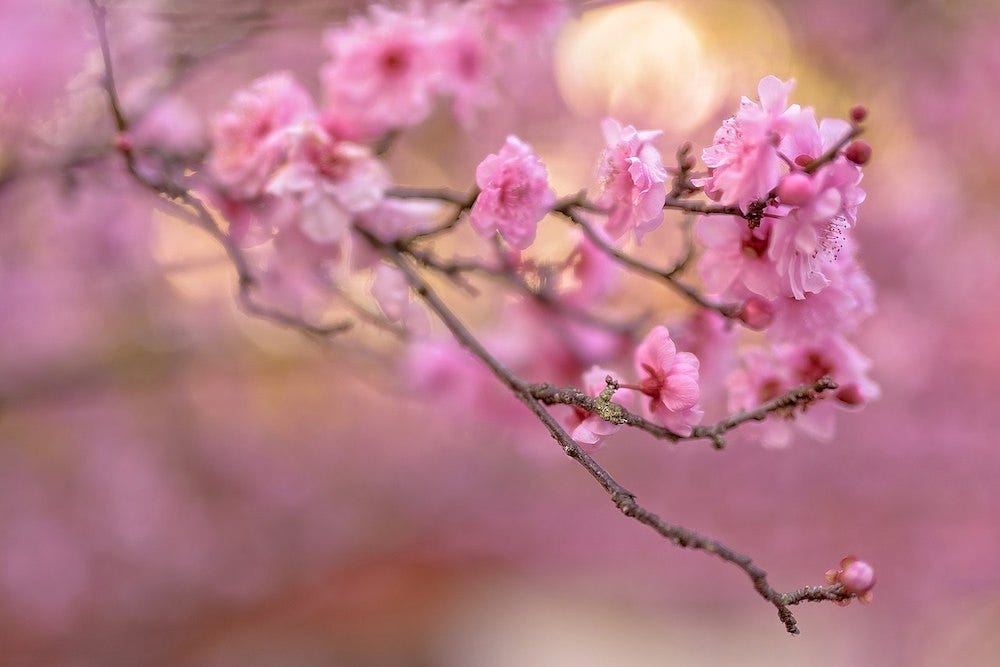A bottle of pisco, Peru’s grape brandy, flies across the Pacific to become a springtime cocktail in the hands of Hisashi Sugimoto—the octogenarian bartender who’s been shaking drinks at Tokyo Station since 1958.
Sakura and Nikkei

Sakura cherry blossoms mark the beginning of spring in Tokyo. Once they bloom, they are everywhere, coloring the city’s riverbanks, parks, sidewalks, and temples. There are even festivals that celebrate their ephemeral beauty, and it seems everyone enjoys a bento box lunch under a sakura tree.
Sakura also connect Japan and Peru.
Sakura Maru is the name of the ship that carried the first Japanese from Yokohama to Lima in April of 1899. So every spring, I think of the immigrants that cooked a fusion of Japanese and Peruvian food and gave birth to nikkei cuisine.
These are dishes like ceviche with ginger, nori, and scallions or ceviche’s cousin, tiradito—sashimi cured in citrus with hot peppers. Today, nikkei cuisine is gaining global recognition, and among Lima’s nikkei restaurants, Maido is ranked No. 7 on The World’s 50 Best.
Inspired to learn more about the roots of nikkei, I travelled to Japan to learn about ingredients, techniques, and the minimalist aesthetic of kaiseki cooking that has inspired some of my own dishes.
I travel very light, a carry-on luggage with room to bring back omiyage souvenirs. But on one trip to Tokyo, I brought something special with me—a bottle of pisco, Peru’s grape brandy, as a gift for legendary bartender Hisashi Sugimoto.
Sugimoto-san and Tokyo Station
Sugimoto-san has been tending bar at Tokyo Station, the hotel and train station in Tokyo, since 1958. When I met him, he told me he retired but came back to Bar Oak to celebrate the station’s 100 year anniversary.
And he’s still there.
Sugimoto-san’s story behind his signature cocktail, “Tokyo Station,” moved me. The ingredients, he shared, represent international travelers—gin for London, Suze for France, pomegranate for Japan, and lime for Mexico.
While the cocktail’s color represents the old brick facade of the train station, drinking it is a metaphor for life’s journey.
Sipping the first half of the drink symbolizes the sweet arrival of the train into the station. Then, after squeezing the lime garnish into the drink, finishing the cocktail evokes the taste of the train’s bitter departure.
The tradition of gifting is ingrained in Japanese culture. So, to show my gratitude and appreciation to Sugimoto-san’s lifelong craft and the story he shared about his signature cocktail, I gifted him something uniquely Peruvian, something that was missing from his bar—a bottle of pisco.
Sakura and Pisco Cocktail
Standing in front of Sugimoto-san, and extending both my arms, I bowed and offered the wrapped bottle of pisco lying horizontally on my hands. I told him this was a special spirit from Peru. Surprised at the gesture from a stranger, he accepted my gift and took it behind the bar.
Quietly, Sugimoto-san lined up several champagne flutes on the bar top, and began to make a round of pisco cocktails for everyone. First, he added pisco, citrus, and sakura syrup to a shaker with ice. Then, he shook and strained the drink into the flutes, and topped them off with champagne.
Though the structure of the drink resembled the classic French 75, I wondered if this was the first time anyone had made a cocktail with these flavors, a nikkei combination of Japanese and Peruvian ingredients.
As I sat at the bar, Sugimoto-san walked around the room, gestured at me with an open palm, and offered the sakura and pisco cocktail to the guests.
One by one, the guests came up to me, introduced themselves, and presented their business cards with both hands as a sign of gratitude. I stood up to bow and receive the cards, honored to participate in this ritual.
I asked Sugimoto-san how much longer he thought he would be a bartender, he did come back from retirement, after all. He exclaimed, “One hundred more years!”
To end the night, I asked him for one more drink, something new. Sugimoto-san poured me a drink with scotch, benedictine, and grapefruit juice, served up in a coupe.
“Original cocktail,” he whispered, and wrote the name on a coaster: “Get Off the Train.” And that, I realized, was the antidote to the bitter departure from Tokyo Station. Just get off the train, and stay.






I'm not much of a drinker but I may have to make an exception and try to visit Sugimoto-san at Tokyo Station. Thank you for the introduction to nikkei cuisine.
They look delicious! 🌸